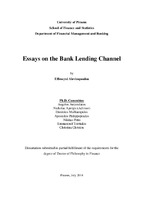| dc.description.abstract | The bank lending channel is one of the many channels through which monetary policy makers transmit their decisions to the economy. This channel operates through loan supply and its existence reflects asymmetric information in credit markets. However, not much attention was paid on the specific channel; by contrast, money view prevailed, since, according to monetarists, only two assets exist in an economy: money and all the other assets – with the latter assumed to be perfect substitutes for each other. This concept, however, changed throughout the years, since the significant role of banks became more obvious, especially due to information asymmetry that exists between lenders (and particularly banks) and borrowers, in conjunction with the fact that non-monetary assets have no perfect substitutes.
This view – credit view – emphasizes the fact that monetary policy affects economy not only through interest rates, but also through other asset prices, which prove to be useful in many applications, supporting the specific view (Mishkin, 1996). Nevertheless, the last few decades – that is, prior to recent crisis – literature overlooked the role of banks as financial intermediaries and hence the bank lending channel had been undermined, mainly due to financial system developments.The purpose of this thesis is to investigate the operation of the bank lending channel and specifically, how it is affected by the following three distinct issues: First, it examines whether bank system efficiency alters the way monetary policy decisions are transmitted through lending channel. The largest part of literature explores the impact that quantitative characteristics have on the operation of the specific channel,
12
whereas the impact of qualitative ones – such as efficiency – has widely remained unexplored, especially in the case of European banks. Second, it employs the endogenously determined target interest rate emanating from the central bank’s monetary policy rule and examines the impact it has on the operation of the bank lending channel. To the best of my knowledge, this approach is novel. Finally, it explores whether disturbances in the financial intermediation – such as those of recent crisis, and specifically, disruptions in the supply of intermediated credit – affect bank lending and therefore, whether they should be taken into account for the investigation of the lending channel. Very few efforts have been made to examine the role of frictions in the lending channel and the impact they have on the response of banks to a monetary policy contraction.
The first paper (Chapter 3) investigates whether lending differentials depend on a qualitative bank-specific characteristic, that is, bank efficiency, which measures the performance of a bank relative to a best-practice bank that faces the same exogenous conditions. Therefore, by allowing the ranking of banks, it recognizes the best and worst practices. Literature distinguishes among three main types of efficiency: productive, cost and profit. This paper examines profit efficiency, which is assumed to be the most complete method – of the three aforementioned – since its objective is to simultaneously minimize production cost and maximize revenues. Specifically, profit efficiency measures the ability of a bank to maximize its profits under certain conditions. | |



